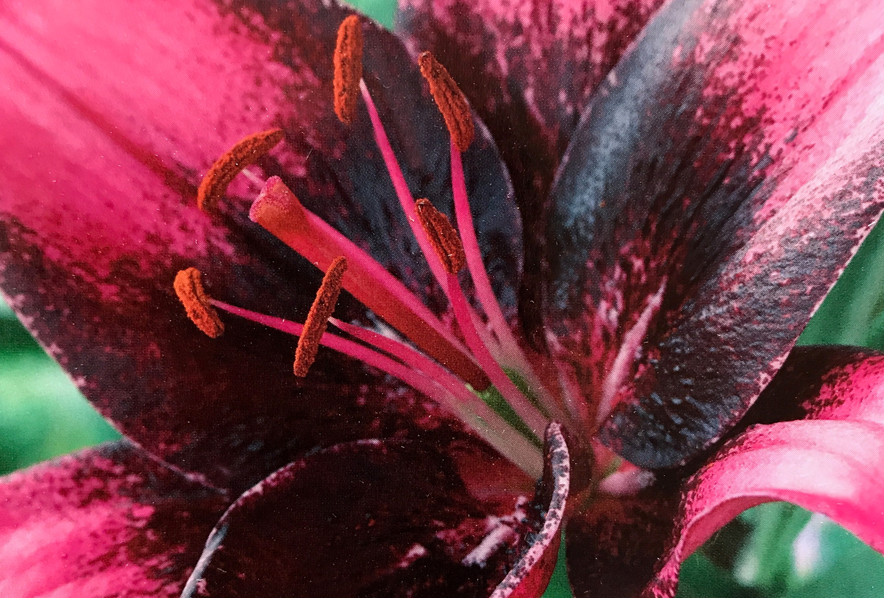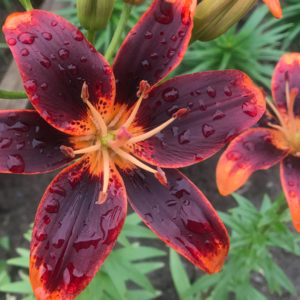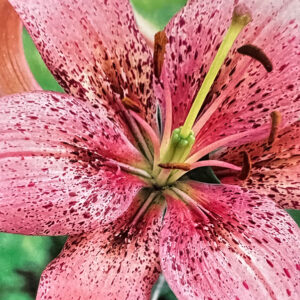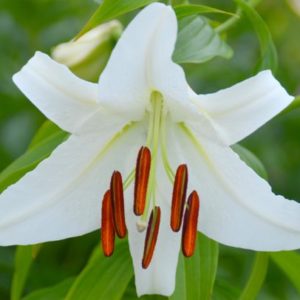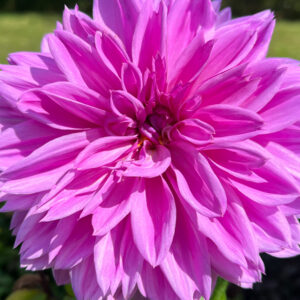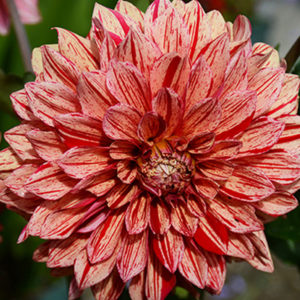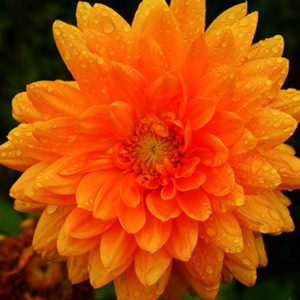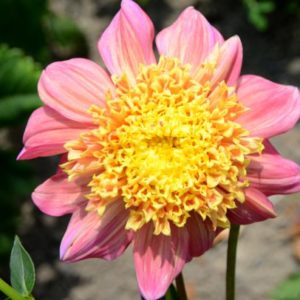Description
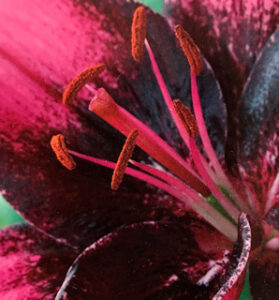 Asiatic Lily,
Asiatic Lily,
Purple Dream
The lilium genus, surprisingly, is only indigenous to the temperate zones of the Northern Hemisphere, but it has been so popular for so many centuries that it is worldwide in distribution. There are many, many species native to North America, Asia and Europe. Flowers are of many different sizes and shapes – some highly fragrant, some not. Lilies were a part of the Greek and Roman civilizations. New World lilies and the lilies of China and Japan were quickly and eagerly embraced by Europeans and the British.
Since the Renaissance, the development and cultivation of lily cultivars has proliferated, but it was not until the late 1800s that the most significant lily introductions were created. E. H. Wilson (1876-1931), the Director of The Arnold Arboretum outside of Boston, MA introduced L. davidii, L. regale, and L. sargentiae. These three lily species became the most important lilies of the 20th century.
Asiatic Lilies are the most popular lilies grown today, and since the mid-20th century, more development work has been done on this group of lilies than all the rest. Most of the Asiatics available today have in their lineage the DNA of one of the greatest species lilies of all time, L. regale. L. regale was discovered in 1903 by Ernest “Chinese” Wilson, the Englishman who became the Director of The Arnold Arboretum, one of America’s most prestigious horticultural assets.
In her marvelous book, BULB, Anna Pavord relates the story of the Wilson’s discovery as described by Wilson himself. Wilson came across the lily, by accident, in a remote, inaccessible area of western China known as the Min Valley. He wrote,
“There in narrow, semi-arid valleys down which thunder torrents, and encompassed by mountains composed of mudshales and granites, whose peaks are clothed with snow eternal, the Regal Lily has its home. In summer the heat is terrific, in winter the cold is intense, and at all seasons these valleys are subject to sudden and violent windstorms against which neither man nor beast can make headway. There, in June, by the wayside, in rock crevices by the torrents edge, and high up on the mountainside and precipice, this lily in full bloom greets the weary wayfarer. Not in twos or threes, but in hundreds, in thousands, aye, in tens of thousands.”
Wilson, on this specific collecting trip gathered thousands of lily bulbs. Three thousand bulbs made it back to England and were cultivated. L. regale was introduced and made available to the British public in 1905. Its instant popularity has not diminished since.
Asiatic Lilies are so beloved because they tend to be shorter than either the Oriental Trumpets or the Orientals. Rarely are they taller than 30 inches. They are vigorous and love containers as well as the open garden. Some are fragrant; some are not. Their blossoms come in a wide range of colors and shapes. They epitomize every quality that we gardeners seek in a flower.
Bi-colored lilies have been around for centuries, but in the latter half of the 20th century, several bi-colored cultivars were introduced with black centers and contrasting coloration on the ends of each petal. This is unusual for lilies, because most bi-color lilies have light colored centers and dark colored ends of petals. One of the most famous was Netty’s Pride, a black centered, white tipped bi-color. Easy Dance, Purple Dream and Forever Susan are most likely related to Netty’s Pride. The plants are 24-36 inches tall and hardy from Hardiness Zones 3-9.
Purple Dream, like Easy Dance, is one of the rare bi-colors which produce blossoms that are jet black in the center and lighter colored near the ends of the petals. Purple Eye has a deep blackish purple center that fades gently to a stunning reddish purple on each petal. This organization of petal color variation is unusual for lilies, because most bi-color lilies have light colored centers and dark colored ends of petals. One of the most famous was Netty’s Pride, a black centered, white tipped bi-color. Purple Dream is most likely related to Netty’s Pride. The plants are 32-40 inches tall and hardy from Hardiness Zones 3-9.
Planting Lilies in Your Garden
Two important facts that must be remembered when cultivating lilies is that they cannot stand wet feet. They need well drained soil, and if they do not have this, they will rot quickly. The second fact is lily bulbs are never dormant. There is always some activity going on in the bulb. It can be strengthening due to seasonal exposure to cold, food transference from roots to scales and scales to the growing point or top growth production. Because of this constant activity, lilies must be handled gently at all times.
To plant lilies in the ground, dig holes that are 8-10 inches deep and dust the holes with bone meal (1/4 cup per bulb). Place the bulb in the hole, pointed side up, and fill the hole with soil. Lilies prefer organically rich soil, so mixing peat moss, compost, and/or dehydrated cow manure into the soil produces stronger plants and more flowers. The Oriental Trumpets and the Oriental lilies should be planted12-14 inches apart. The Asiatics should be planted 12-14 inches apart.
Once the lilies have emerged from the soil, you can fertilize with a blossom booster fertilizer, but you do not have to do this. You will still get beautiful blooms if you do not fertilize at all. Lilies also like their heads in the sun and their feet in the shade. This can be accomplished by planting low growing annuals like alyssum, ageratum or non-vining nasturtiums where you are also growing the lilies or planting the lilies beneath shrubs or perennials.
Dividing or moving lilies should be done in the fall of the year about every 3-5 years.
Planting Lilies in Containers
Lilies LOVE being grown in containers, but the containers must be deep – at least 10-12 inches. Use the soil mix described in detail in our Harvesting History YouTube video. Do not use prepared soil mixes.
The Best Soil Mix for Containers
Briefly the soil mix is 60% topsoil, 20% peat moss and 20% compost or dehydrated cow manure. You can plant according to the following chart:
| Type | 10-12 inch | 14 inch | 18 inch |
| Asiatics | 3 Bulbs | 5 Bulbs | 10 Bulbs |
| Orientals | 2-3 Bulbs | 3-5 Bulbs | 6-8 Bulbs |
| Oriental Trigrinum | 1 Bulbs | 1 Bulbs | 2 Bulbs |
Plant the bulbs 8 inches deep. Dust the hole with ¼ cup bone meal per bulb. Cover the bulbs with 8 inches of soil. Water heavily, but do not allow the pots to stand in water. Once the lilies have emerged from the soil, fertilize every two weeks with blossom booster fertilizer.
In the fall, when the top growth has died completely back, remove the dead growth and dust the surface of the soil with bone meal. Mulch with 2 inches of compost, if possible, or a mix of peat moss and dehydrated cow manure-5 parts peat moss to 1 part manure.
Make sure you water your lilies throughout the summer. Do not allow the pots to dry out.
Harvesting History has a collection of YouTube videos on Asiatic and Oriental Lilies. Click on the individual link to view each video.
LILIES-THEIR HISTORY AND BACKGROUND
PLANTING LILIES
ORIENTAL TRUMPET LILIES
ASIATIC LILIES
ORIENTAL LILIES PART I
ORIENTAL LILIES PART II

